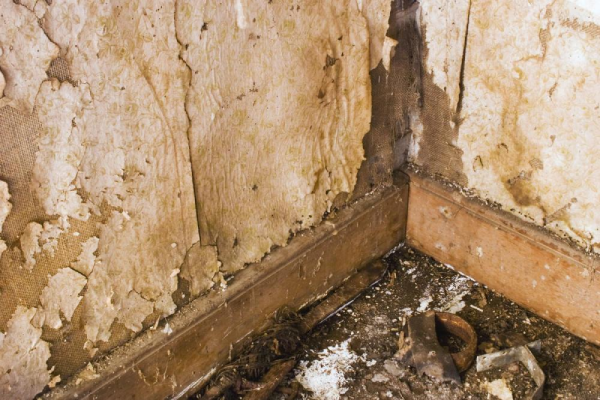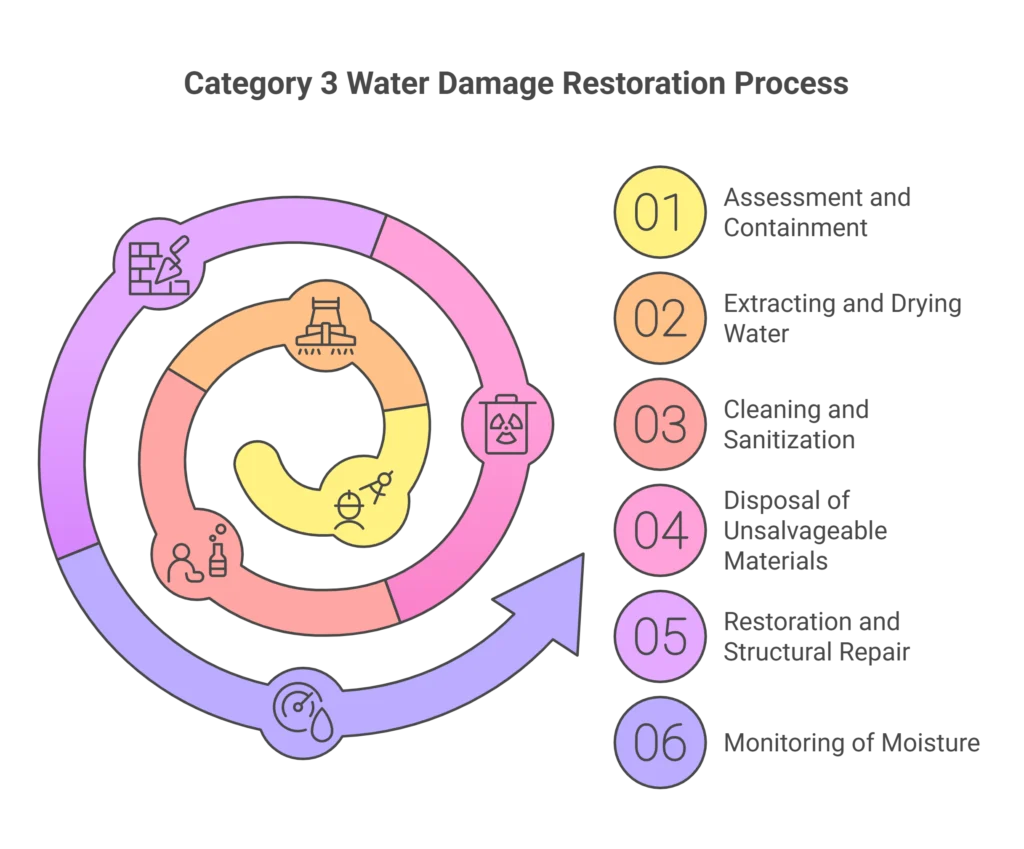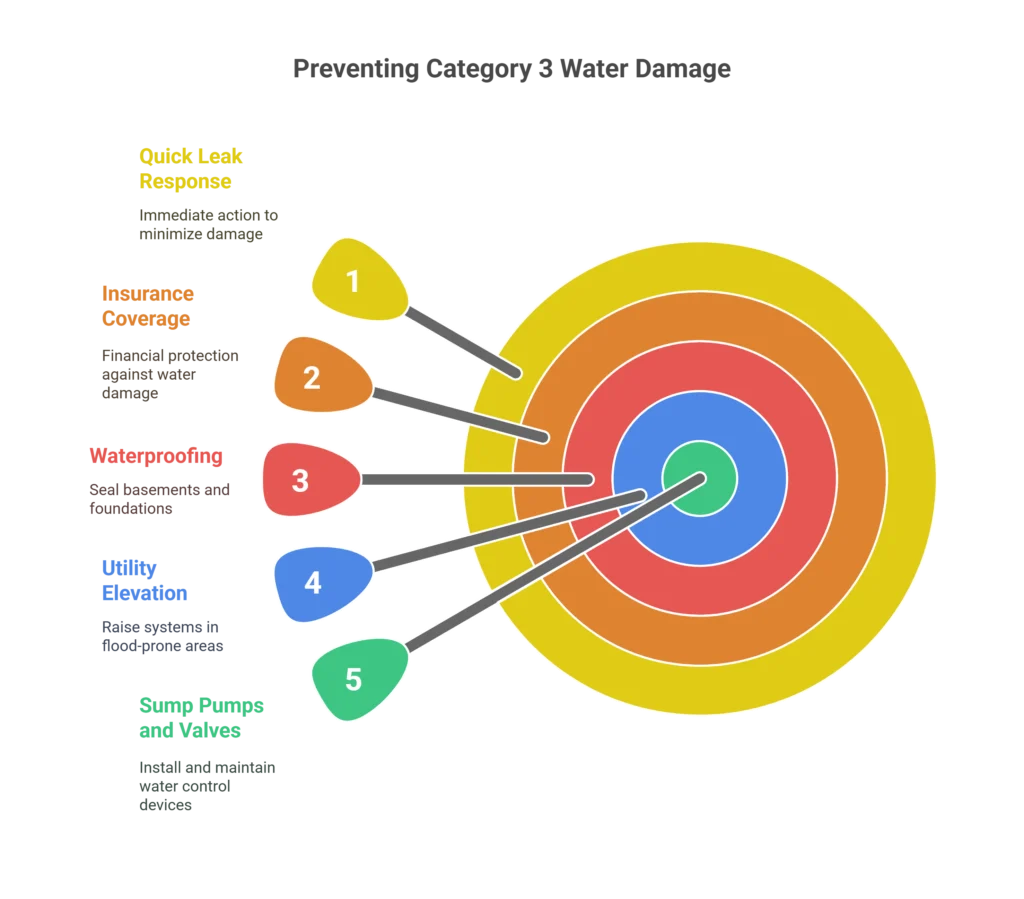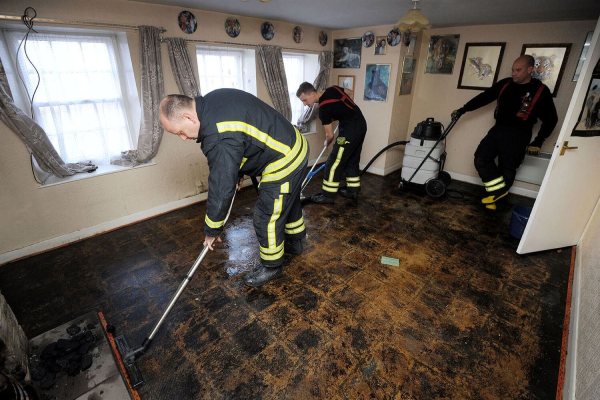Category 3 water damage, often known as Black Water, represents the most dangerous form of water intrusion that can harm any building. It contains contaminated water full of pathogens, poisonous chemicals, sewage, or organic waste that creates serious health dangers for anyone who comes into contact with it. Places like Vancouver, where floods from storms and heavy rains are frequent, need property owners to understand how cat 3 water damage can be. Taking quick and expert steps is important to reduce health dangers and avoid permanent harm to the structure.
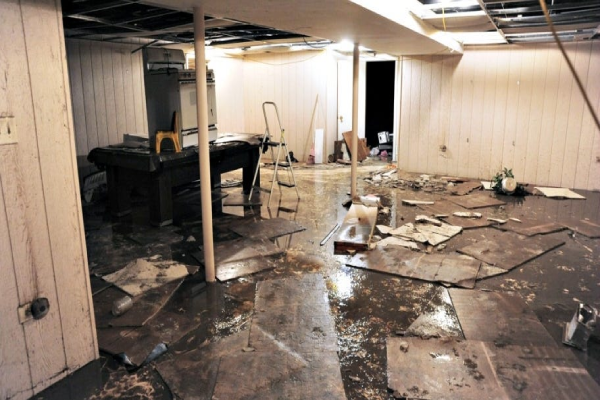
Common Sources of Category 3 Water Damage
What is cat 3 water? Category 3 water can come from many polluted sources, including:
- Sewage backing up and spilling from toilets or septic tanks
- Floods caused by heavy rain, hurricanes, or city storm surges
- Sea water getting into buildings during high tides or storms
- Runoff from the ground containing oil, pesticides, and trash
- Water from rivers or lakes that enter homes or businesses when flooding happens
- Any water that is untreated for more than 48–72 hours
Real-World Example:
According to the research of Northern Arizona University (NAU), a retail warehouse in North Vancouver faced major contamination when a nearby river flooded water entered through its ground-floor entrance. Experts with IICRC certification stepped in to treat mold growth and bring the building back to a safe condition. They used tools from companies such as Jon-Don to clean up and fix the damage.
Comparison: Category 1 vs. Category 2 and 3 Water Damage
Understanding the differences between the categories of water damage helps in choosing the right methods. Here are the differences between cat 3 black water and category 1 and 3:
| Category | Source of Water | Contamination Level | Health Risk |
| Category 1 | Clean water (e.g., broken supply lines) | Low | Minimal |
| Category 2 | Grey water (e.g., washing machine overflow) | Moderate | Moderate health concerns |
| Category 3 | Black water (e.g., sewage, floodwater, seawater) | High | Severe and dangerous |
Note: Category 2 damage can escalate to Category 3 if you do not treat it fast.
Restoration Steps for Category 3 Water Damage
Dealing with Category 3 damage is not a DIY job. Because of the dangerous nature of the water, IICRC-certified professionals must handle it by following strict safety protocols and industry standards. What is a category 3 water damage needed process? Here are the steps:
1. Assessment and Containment
To avoid more contamination, technicians determine the level of contamination and isolate the impacted area.
2. Extracting and Drying Water
To stop microbial growth, all standing water and moisture are eliminated by using industrial-grade pumps and dehumidifiers.
3. Cleaning and Sanitization
Experts use EPA-approved antimicrobial solutions to treat surfaces to remove viruses, fungi, and pathogens.
4. Get Rid of Materials That Cannot Be Saved
Following local laws, contaminated insulation, carpets, and drywall are safely removed and disposed of.
5. Restoration and Structural Repair
They use mold-resistant materials to restore damaged walls, floors, and ceilings to their pre-loss state.
6. Monitoring of Moisture
Before the final actions, instruments like moisture meters and thermal imaging cameras make sure that all concealed moisture has been removed.
The entire procedure of category 3 water damage restoration conforms with health and safety regulations thanks to reputable businesses like Revie Restoration, SERVPRO, or other regional certified teams.
Prevention Tips: How to Avoid Future Category 3 Water Damage
It is less expensive to prevent cat 3 black water damage than to repair it. Here are some tips to avoid future damage:
- Install sump pumps and test them before the rainy season
- Use backflow prevention valves in homes that are susceptible to sewer backups
- Inspect and maintain plumbing and sewer lines regularly
- Increase utilities and HVAC systems in flood-risk areas
- Waterproof basements and foundation walls with sealants
- React quickly to any leak, no matter how small it is
- Get insurance that covers sewage and flood damage.
Insurance Coverage: What You Should Know
Most standard homeowners’ insurance does not cover Category 3 water damage caused by natural flooding or sewer backups. You will need additional policies such as:
- Flood Insurance (through private insurers or FEMA)
- Endorsements for Sewer Backup
- Commercial property business interruption insurance
Always check the details of your policy and request coverage specific to Category 3 from your insurance agent. Expert restoration firms can also help with supporting and documenting claims.
Water Damage Restoration in North Vancouver
If you’re dealing with Category 3 water damage in North Vancouver, trust local experts who understand the area’s drainage challenges. Professional water damage restoration in North Vancouver includes:
- 24/7 emergency service for flood or sewage backups
- Quick dispatch to North Shore areas
- Specialized containment and disposal services
- Using cutting-edge drying technologies and preventing mold
- Collaboration with your insurance provider
For reliable water damage restoration North Vancouver, contact us today for fast and professional service to restore your property to its best condition.
Water Damage Restoration in West Vancouver
Properties in West Vancouver are susceptible to stormwater damage, basement flooding, and seawater intrusion, particularly if they are close to the coast. Choose a West Vancouver water restoration company that offers:
- Knowledge of coastal and hillside drainage systems
- Access to air scrubbers and HEPA vacuums
- Experience in luxury property restoration
- Professional service for high-profile clients
- Full agreement with IICRC and municipal regulations
For trusted water damage restoration West Vancouver, contact our expert team to ensure your property receives the highest standard of care and restoration.
Fast Water Damage Repair with Revive Restoration Company
When water damage happens, you need help fast. Revive Restoration Company is here to respond quickly and do every step correctly. Our team knows what is a category 3 water loss, so our staff arrives fast, finds the problem, and starts repairs right away. We use top equipment to dry and fix your space so you can get back to normal life sooner. You can count on us to treat your home with care and restore it fast. Call us now to reserve our services.
FAQs
- What is Category 3 water damage?
It’s the most dangerous type of water damage, filled with harmful bacteria and contaminants. - What are common sources of Category 3 water damage?
Sewage backups, floodwaters, and toilet overflows with waste are typical sources. - How is Category 3 water damage different from Category 1 and 2?
Unlike the cleaner water in Categories 1 and 2, Category 3 water poses serious health risks. - What steps are involved in restoring Category 3 water damage?
It involves protective gear, full removal of affected materials, deep cleaning, and thorough drying. - Is Category 3 water damage covered by insurance?
No, the coverage depends on your policy and the cause of the damage.

